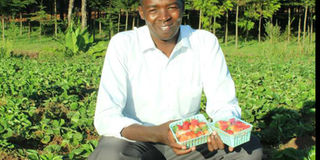In strawberry, I found my second job and career

Isaac Chumba,27, on his strawberry farm in Kaptagat, Ainabkoi in Uasin Gishu county. He has been growing the plants for the last decade. PHOTO| STANLEY KIMUGE|NATION MEDIA GROUP
What you need to know:
- Chumba practices ‘shift cultivation’ which involves letting the farm stay fallow for six months before planting once again
- Shift cultivation, according to him, helps to improve soil fertility and break disease cycle
There are two ways of growing strawberry depending on the variety, which is through seeds or through transplanting runners or splits
The sky is clear as we drive from Eldoret town towards Kaptagat in Ainabkoi, some 16km away.
Our destination is on an eight-acre farm in Teltet village where farmer Isaac Chumba grows strawberry, among other crops.
Over half of the farm hosts maize, collard greens (sukuma wiki) and beans in different portions.
The other part, about some three acres, hosts the sweet strawberry plants.
“I plant them at different times to ensure I have produce all-the-year round. The ones over there I planted early September while the others last year,” says Chumba as he squats to check on a fruit.
Shift cultivation
Chumba practices what he calls ‘shift cultivation’ which involves letting the farm stay fallow for six months before planting once again. This is different from crop rotation where one plants a separate crop from a different family to break the disease cycle.
Shift cultivation, according to him, helps to improve soil fertility and break disease cycle.
“I learnt this technology through online research and tried it on my farm and it worked,” he says.
The farmer grows the Chandler strawberry variety, which he notes offers bigger and sweeter fruits that have a longer shelf-life.
Different ways of growing
There are two ways of growing strawberry depending on the variety, which is through seeds or through transplanting runners or splits.
The farmer plants using seeds. Though one may apply NPK 23:23 fertiliser, Chumba mainly uses organic manure since it’s readily available.
He first prepares the manure from cows and poultry by composting it for three months to help control diseases.
Later after tilling the land, he plants the berries using a handful of compost manure per hole.
“The spacing needs to be 30 by 45cm because after two years, the plants would occupy more space. After planting, it is important to ensure there is enough supply of water.”
But immediately after planting, he sprays insecticides regularly to control pests like caterpillar until the third month. Thereafter, in a month, he top dresses with CAN or applies foliar fertiliser to enhance vegetative growth.
After some days of planting, flowers normally sprout. However, Chumba says he removes them until after the plants have reached the third month to protect the fruit.
At the third month, he sprays the plants with a foliar feed for fruit development and starts picking the berries in the fourth month. Later, he regularly sprays to control pests such as spiders that feed on the fruits.
He uses furrow irrigation, which he says is cheaper as compared to drip or sprinkler, getting water from the nearby River Chepkero.
The crop, according to him, requires plenty of water. “If you have a reliable water supply and control diseases, you will harvest big,” explains the 27-year-old, who has been growing the fruits for about five years.
Marketing challenge
Chumba, who holds a Bachelors Degree in Procurement from Mount Kenya University, went into strawberry farming when about 20 years.
At first he had the challenge of market since the crop was still new.
“Some thought it was wild crop but with time people started to like it,” notes Chumba, who started the business with Sh10,000.
In a week, he harvests up 1,000 250g packs of the berries selling each for Sh80. He supplies the berries to supermarkets, bakeries, coffee shops and to traders at the Eldoret market.
He further sells seedlings at Sh40 each especially during the rainy season.
“The plant begins to fruit from three to four months after planting. One can harvest the fruits until after two to three years,” he says, adding the crop requires intensive weeding every two weeks to curb diseases, which include black root rot, botrytis and leaf spot.
Value Addition
The best season for the crop is from mid-December to late March, when there are no rains which often lead to root rot and leaf spots, says the farmer.
Chumba, who works as the branch manager for Resolution Insurance in Eldoret, finds time to visit his farm every weekend to check on the progress of the crops, although he has employed four workers.
Besides diseases, birds are another challenge as they feed on the fruits, destroying them.
Chumba plans to increase the acreage of the plant to 10 acres and start to add value to the produce by making jam.
Benjamin Lagat, an agricultural officer with the Uasin Gishu county government, advises that while one can leave a farm fallow, they better plant other crops of different family to that of strawberries.
“One can plant cereals such as maize or wheat or even oats to break the disease cycle in the soils, a thing shift cultivation may not do.”





